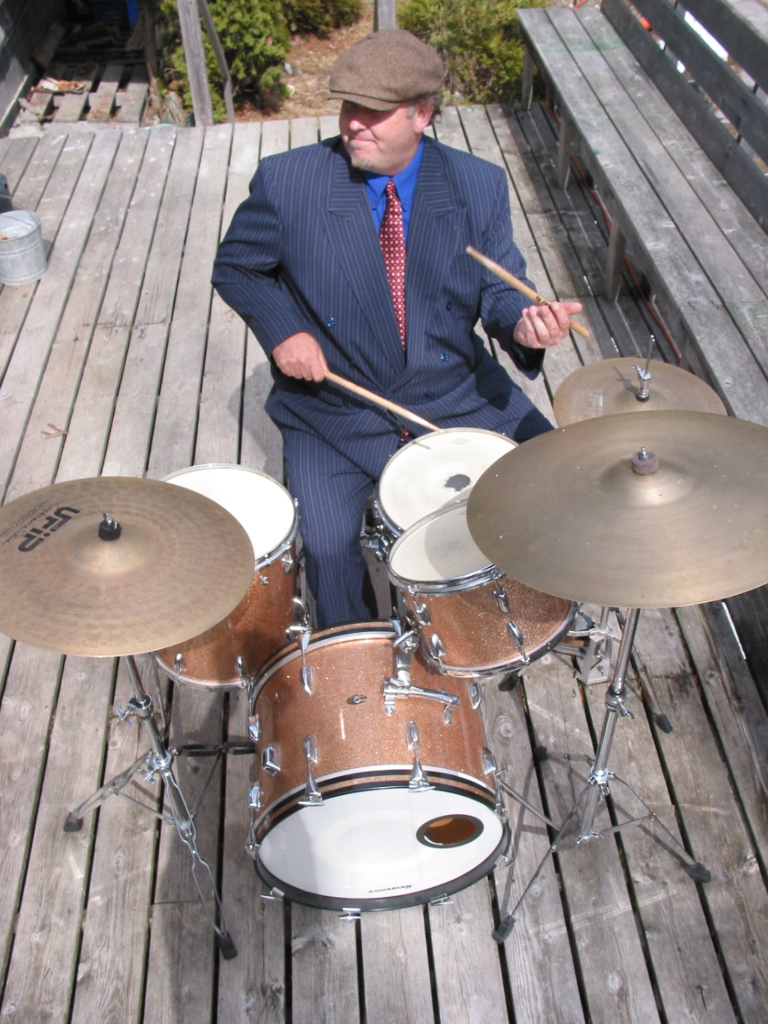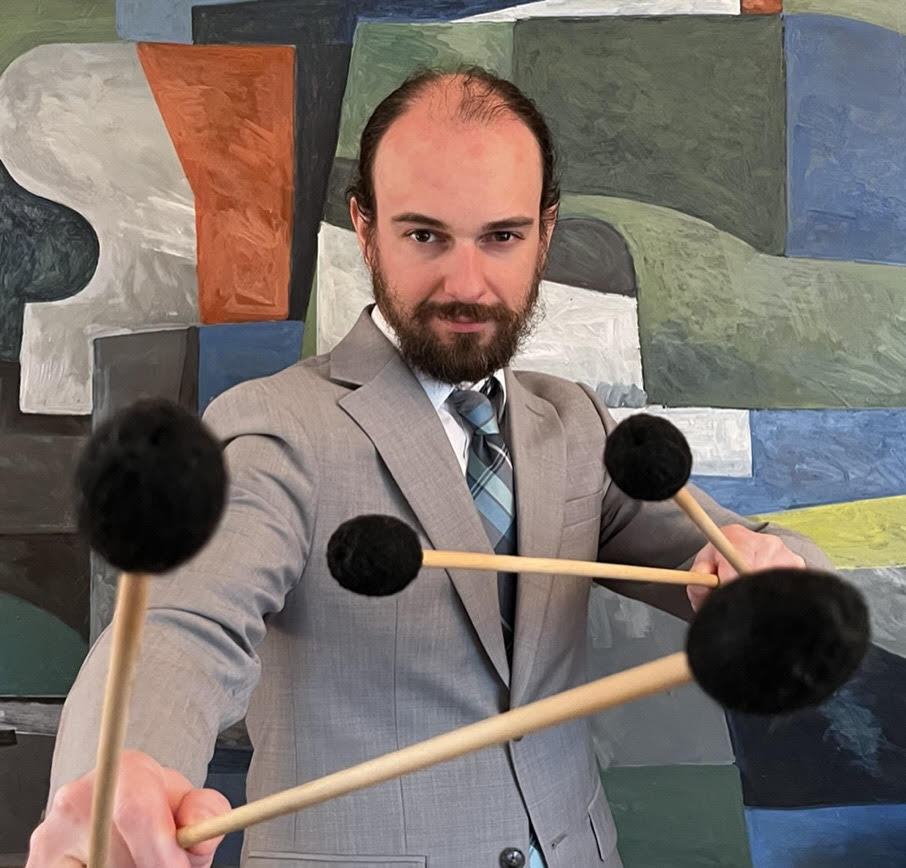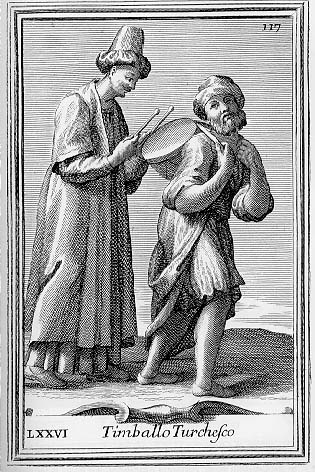The Music Division of the School of Performing Arts at the University of Maine offers a wide range of opportunities for percussionists of both music major and non-music major standing.
All percussionists from across campus, regardless of college or major are invited to participate in our excellent performing ensembles. In some cases, applied lessons may be appropriate for non-music majors.

Dr. Stuart Marrs
Professor of Music Emeritus
marrs@maine.edu

Mike Bennett
Drum Set and African Percussion. Percussion Ensemble
michael.andrew.bennett@maine.edu

Michael Venti
Concert Percussion, Percussion Ensemble
michael.venti@maine.edu

Chris White
Sports Bands, Percussion Methods
cgwhite@maine.edu
Percussion Audition
A personal audition with the percussion instructor or an audition video recording will determine the student’s ability and appropriate placement level. Proficiency in at least one of the following main areas and a working knowledge in any one of the other listed areas is required for entrance into percussion studies.
If you intend to submit a video recording as an audition, please post the video to YOUTUBE with a “Private” visibility setting and call the School of Performing Arts at 207.581.4703 for instructions on where to send the YOUTUBE link.
The first 4 areas represent the “main” areas.
1. Snare Drum
A strong rudimental background in snare drumming as demonstrated by performance of solos by Wilcoxon, Markovich, or equivalent; and/or concert style snare drum performance from Cirone, Albright, Firth, Peters or Goldenberg books or the equivalent. If concert style snare drum solos are chosen exclusively, then the playing of rudiments may be requested.
If this category is chosen as a secondary audition instrument, then more elementary material may be chosen.
2. Timpani
A basic knowledge of the mechanical and pitched characteristics of the timpani; a performing command of two drum exercises as found in the Modern Method for Timpani by Saul Goodman; a basic understanding of intervals and scales and ability to hear, sing and tune them on the timpani.
If this category is chosen as a secondary audition instrument, then the singing and tuning of intervals and scales will not be required.
3. Keyboard percussion
A basic playing and/or theoretical understanding of major and minor scales and arpeggios; a reading command of intermediate difficulty literature such as found in Modern School for Xylophone, Marimba, and Vibraphone by Morris Goldenberg or the equivalent. A solo work of two or four mallets demonstrating the student’s current level of technical ability.
If this category is chosen as a secondary instrument, then only major scales will be required and an elementary level solo may be presented.
4. Drum Set
A strong command of jazz, rock and other musical styles of drum set performance must be demonstrated through performance of “playing time,” improvising fills, and solos in each style; and a basic understanding of chart reading displayed by performance with recorded music or live musicians.
If this category is chosen as a secondary audition instrument, then more elementary material may be presented.
Areas five and six are not to be considered “main” areas, but may be used, if the student so desires, as secondary audition instruments or areas.
5. Accessories
Demonstration of varied techniques on: tambourine, triangle, cymbals, bass drum etc. as found in the orchestral repertoire section of the Goldenberg, Modern School for Snare Drum.
6. World percussion
Proficiency in one of the following: Latin percussion, tabla playing, Middle Eastern hand drumming, Baroque tambourine technique, or any other exotic percussion practice not listed above.
For the BA in Music with a Concentration in Jazz Studies it is only necessary to audition on drum set.
Required for entrance into the program:
- Basic proficiency for comping and fills in the following styles:
- Swing/bop
- Funk
- Latin
If you have any questions regarding these requirements or the percussion program at UMaine in general, please do not hesitate to call or pay us a visit.
- Bachelor of Music in Performance
- Bachelor of Music in Music Education with a concentration in percussion
- Bachelor of Arts with a major in music
- Bachelor of Arts with a Concentration in Jazz Studies
- Music Minor
- Master of Music in Performance
- Master of Music in Music Education (with optional emphasis in conducting).
Percussion Ensemble – MUO150
The University of Maine Percussion Ensemble has a distinguished history of performance within this relatively new genre of musical activity. The group has premiered new works in the US such as the Živković Uneven Souls as well as performing “older” staples of the repertoire like Chávez’s Toccata (1942) and Varèse’s Ionisation (1931). In 1993, the group was invited to perform at the Percussive Arts Society International Convention in Columbus, OH where its performance of the above-mentioned work by Nebojša Jovan Živković was heralded as the “best of the conference.” The group toured internationally on several occasions and was the first US percussion ensemble to perform in Cuba at the PerCuba Festival in 1999. Mixed in with the more European-based compositions, the ensemble performs in a variety of world music genres such as salsa, African drumming, and Brazilian samba.
This group performs chamber music composed primarily for the medium of percussion. The specific repertoire chosen for a given semester depends greatly upon the make-up of the ensemble for that semester. The ability to read music (e.g. snare drum parts) is a prerequisite for enrollment in this performance course. Although it is NOT absolutely necessary to read pitches, percussionists with experience on keyboard percussion and timpani are strongly encouraged to enroll. Dr. Stuart Marrs, Director. Rehearsals are Tues. 5:00-7:00pm. 0-1 cr.
Symphonic Band – MUO114
The Symphonic Band performs the most challenging and significant band literature and offers the accomplished percussionist a satisfying artistic experience. Rehearsals are MW 4:00-5:20. Audition required. Director of Bands, Christopher White, Director. 0-1 cr.
Marching Band – MUO111
The drum line for the Black Bears Marching Band maintains a standard of excellence unparalleled in the State. Progressive concepts and advanced techniques are routinely employed by students with a drum corps background. The spirit and camaraderie of this precision unit help to provide at once a satisfying musical and social activity. 0-1 cr.
Pep Band – MUO113
An important part of our successful winter sports teams, the Pep Band is an ideal ensemble for the musician/sports fanatic. Many students enroll for the thrill (not to mention the free admission) of UMaine Black Bear winter sports. Audition required. 0-1 cr.
Concert Band – MUO112
Many of the players enrolled in the Black Bears Marching Band during the fall semester choose to continue their music in the spring semester by enrolling in the Concert Band. This organization performs music from the standard concert band repertoire similar to what you experienced in high school band. No audition required. Dr. Phillip Edelman, Director. 0-1 cr.
University Orchestra – MUO 121
The orchestra often performs works from the standard symphonic repertoire that require percussion. Interested percussionists should check with Dr. Marrs and Dr. Wieck at the beginning of each semester to determine percussion needs for the group. Rehearsals are M&W 7:00-9:00pm. Dr. Anatole Wieck, Director. 0-1 cr.
Jazz Ensemble – MUO 143
Usually takes two percussionists for each big band — set playing and vibes with some Latin percussion. There are two sections for this group, i.e. two complete jazz bands. 0-1 cr.
Chamber Jazz Ensemble – MUO 155
There are usually several combos each semester. Each combo can use a drum set player and each is coached by a professional jazz musician. Drum set players with any level of experience in jazz are encouraged to sign up. Dr. Dan Barrett: program coordinator.
Minimum supplies for first-year percussion majors at the University of Maine
This is a list of mallets, books, and gear that you should have to begin your percussion studies at the University of Maine. Since there are many makes and models of sticks and mallets, I will give a generic description followed by some specific examples. If you already own something similar to what is listed you need not purchase new at this time, but as your percussion career continues, you will find that you may very well end up with several different brands of the same kind of mallet.
Budget
In addition to these initial acquisitions, you should budget from $400-$600 a year for new mallets, sticks, books and accessories such as tambourines, triangles, castanets etc.
Where to buy
Your local music store is a valuable resource to the community that deserves the support of your patronage. There are, however, mail order discount establishments that, due to the volume of their trade, can offer very heavily discounted merchandise. You must decide for yourself which route to take. If you decide to use the mail order, I recommend Steve Weiss tel. 1.888.659.3477 or check on Amazon. Be sure to know exactly what make and model you want before you call or search. The sample prices and model numbers below are from SteveWeissMusic.com and are subject to change.
| Description | Make | model | price |
|---|---|---|---|
| set of 4 medium yarn marimba mallets | Vic Firth | M162 | 49.00 |
| set of 4 medium hard yarn marimba mallets | Vic Firth | M163 | 49.00 |
| set of 4 multi-tone yarn marimba mallets | Vic Firth | M164 | 51.00 |
| set of 4 med hard cord-wound vibes mallets | Vic Firth | M32 | 76.50 |
| pair of medium rubber mallets | Vic Firth | M5 | 17.50 |
| Description | Make | model | price |
|---|---|---|---|
| pair of heavy concert sticks | Vic Firth | Ted Atkatz | 8.50 |
| pair of light concert sticks | Vic Firth | SD2 | 6.50 |
| pair of medium or light sticks for jazz | Vic Firth | SPE | 7.95 |
| pair of brushes | Vic Firth | WB | 17.95 |
| Description | Make | model | price |
|---|---|---|---|
| pair Dolce Articulate | Vic Firth | Gen4 | 45.50 |
| pair Staccato | Vic Firth | VFT3 | 24.50 |
| pair Hard Tonal | Vic Firth | Gen6 | 28.50 |
| pair ultra-staccato | Vic Firth | VFT4 | 21.95 |
| pair wood | Vic Firth | VFT5 | 13.25 |
Books
This, of course, depends on your level on each category of instrument. There are many other titles that would also serve our purpose so you may already own alternatives that will work. This list, however, reflects what most of our first-year students end up buying.
| Author | Title | price |
|---|---|---|
| Goldenberg | Modern School for Snare Drum | 18.90 |
| Cirone | Portraits in Rhythm | 10.95 |
| Firth | The Solo Snare Drummer | 9.85 |
| Goodman | Modern Method for Timpani | 17.95 |
| Firth | The Solo Timpanist | 13.45 |
| Reed | Syncopation | 7.15 |
| Chester | The New Breed | 16.15 |
| Goldenberg | Modern School for Xylophone, Vibraphone, and Bells | 16.20 |
| Kraus | Modern Mallet Method — Vol. I | 17.95 |
| Gaines | Sequential Studies for 4-Mallet Marimba | 19.95 |
| Bach | Bach-Bach for Solo Marimba arr. Chen-M | 15.95 |
| Brand | Model | Description | Price |
|---|---|---|---|
| Smartphone app |
Tuner
First of all you need a tuning fork: A440. A tuner would be very handy to check your ear when practicing timpani tuning. The Korg DT-1 works well, but any chromatic tuner would do.
| Brand | Model | Description | Price |
|---|---|---|---|
| Wittner | Tuning Fork: A-440 | 8.95 | |
| Smartphone app |
Stick bag
In order to organize and protect your investment, you should have a stick bag or mallet case. The Stevens Tour Bag is a good choice, but you have many options.
| Item | Size | Capacity | Price |
|---|---|---|---|
| LHS Tour Bag | 36″x21″ | Holds approx. 32 pr. | 79.95 |
or
| Item | Size | Capacity | Price |
|---|---|---|---|
| LHS Half Size Bag | 16″x21″ | Holds approx. 16 pr. | 57.95 |
Total for these items: $648.95 (less what you already own)

